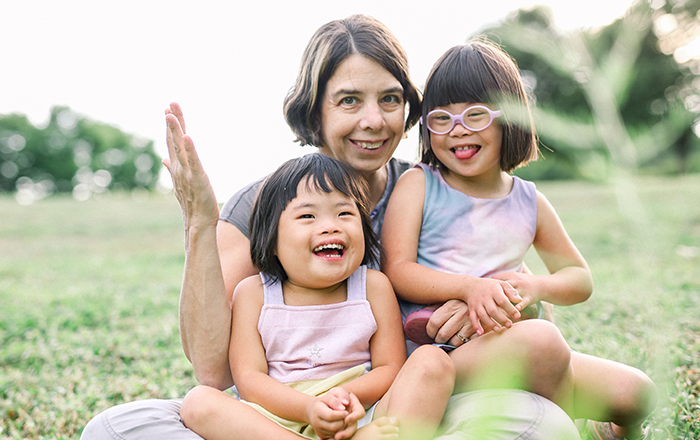I knew nothing about African-American hair care when Tasia, my first foster child, was placed with me at age two. I fell in love with her, and I adopted her, even though that wasn’t my original plan. Her adoption was finalized last year, and I now know a lot more about her hair. I love doing Tasia’s hair, especially now that she’s six and willingly sits still. She likes it to look good.
I want to be known, among other things, as a white mom who knows how to do black girls’ hair.. When I’m alone, I’m just another Berkeley mom. With my black daughter and my multiracial foster kids in tow, I’m self-conscious. I imagine that people notice and remember us. There’s a part of me that wants to be seen as Superwoman. It’s not enough that I care for flocks of kids with no partner to help me. I’ve now demonstrated that I can also do hair, at least well enough for Tasia’s school friends to notice: “Your mom changed your hair again?”
There’s a beauty salon nearby that we drive past all the time.The sign in the window says “Braids and Styles; Children’s Hair; Walk-ins Welcome.” Tasia’s been asking to go there: “I wanna get my hair done perfessinuly.”
My daughter has been exquisitely patient as I’ve learned to style her tightly coiled, medium-length hair: first, making symmetrical parts with a fine-toothed comb and holding the sections together with her hair elastics with the colorful plastic balls—we call them “hair balls”; next, braiding or twisting, then securing the ends with butterfly or flower barrettes. I can do French braids, passable cornrows, and hair extensions.
Yet even after four years of hair-doing, my hands sometimes feel clunky and untrained. I’ve tried dozens of different oils, conditioners, moisturizers, and shampoos, looking for the ones that will make Tasia’s hair easier to comb and style. I do her hair while she’s watching TV. I do her hair while we sit in the tub, a contrast of chocolate and vanilla skin. I do her hair while she sleeps, her eyelashes casting shadows on her cheeks.
Lately I’ve been thinking that it might not be a bad idea to take Tasia to the salon since I’m extra busy these days with two new foster children. The two-year-old has temper tantrums the size of the Grand Canyon, and the baby has a respiratory ailment and needs treatments. I also have a teenage son, Julian. Most days I never stop moving.
Recently, I had an appointment with the reading specialist at Tasia’s school. Tasia’s having a hard time understanding how letter sounds combine to form words. Mrs. Williams, who has a neat, close-cropped natural, nearly the same color as her dark cinnamon-brown skin, told me not to worry. First-graders display a wide range of reading comprehension, she said, and Tasia is making progress—just at her own pace.
As she handed me some books to work with and walked me to her door, she said, “I noticed Tasia’s scalp looks dry. Do you know about putting oil in her hair?” I answered quickly, “Oh, yeah, but we had such a crazy morning—we overslept, and I didn’t have time to put anything in it.” It was true, the morning had been a whirlwind of frantic activity, and I’d neglected to pat Ultra-Sheen onto Tasia’s scalp. But I felt defensive. Can Mrs. Williams really think I haven’t learned to take care of my daughter’s hair? However, I didn’t let my indignation show. I realized that maybe it would be wiser to let someone else braid Tasia’s hair. Then I’d have more time to moisturize it—and to help her with her reading.
The next day, without an appointment, we walked into the small, neat salon around the corner. Yes, they could do Tasia’s hair right away, we were told by a soft-spoken African woman with a rhythmic accent. I decided not to stay and watch. It seemed like a rite of passage for Tasia—her first time at a salon. I would just have to imagine the broad, beautiful smile on her face when she first sees her newly styled hair in the mirror.



